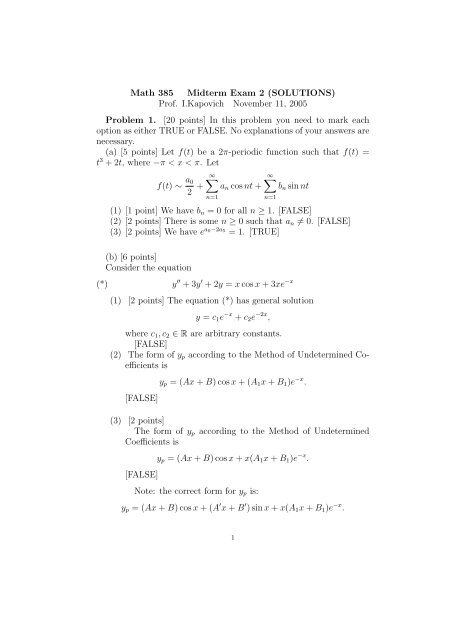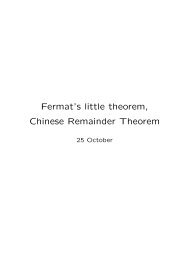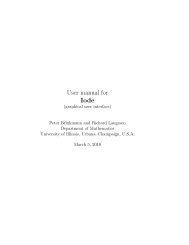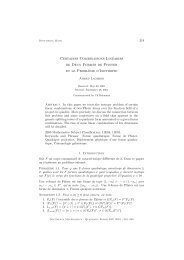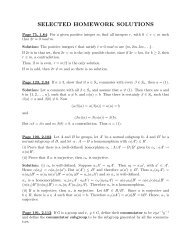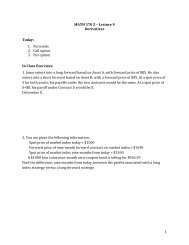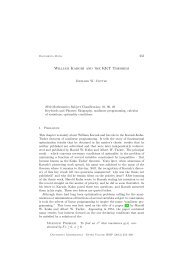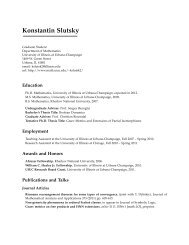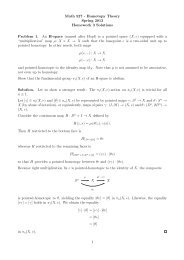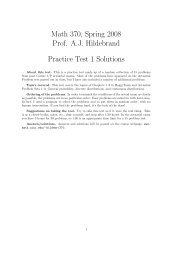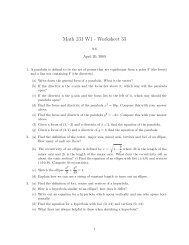Math 385 Midterm Exam 2 (SOLUTIONS) Prof. I.Kapovich November ...
Math 385 Midterm Exam 2 (SOLUTIONS) Prof. I.Kapovich November ...
Math 385 Midterm Exam 2 (SOLUTIONS) Prof. I.Kapovich November ...
You also want an ePaper? Increase the reach of your titles
YUMPU automatically turns print PDFs into web optimized ePapers that Google loves.
<strong>Math</strong> <strong>385</strong> <strong>Midterm</strong> <strong>Exam</strong> 2 (<strong>SOLUTIONS</strong>)<br />
<strong>Prof</strong>. I.<strong>Kapovich</strong> <strong>November</strong> 11, 2005<br />
Problem 1. [20 points] In this problem you need to mark each<br />
option as either TRUE or FALSE. No explanations of your answers are<br />
necessary.<br />
(a) [5 points] Let f(t) be a 2π-periodic function such that f(t) =<br />
t3 + 2t, where −π < x < π. Let<br />
f(t) ∼ a0<br />
2 +<br />
∞�<br />
∞�<br />
an cos nt + bn sin nt<br />
n=1<br />
(1) [1 point] We have bn = 0 for all n ≥ 1. [FALSE]<br />
(2) [2 points] There is some n ≥ 0 such that an �= 0. [FALSE]<br />
(3) [2 points] We have e a0−2a5 = 1. [TRUE]<br />
(b) [6 points]<br />
Consider the equation<br />
n=1<br />
(*) y ′′ + 3y ′ + 2y = x cos x + 3xe −x<br />
(1) [2 points] The equation (*) has general solution<br />
y = c1e −x + c2e −2x ,<br />
where c1, c2 ∈ R are arbitrary constants.<br />
[FALSE]<br />
(2) The form of yp according to the Method of Undetermined Coefficients<br />
is<br />
[FALSE]<br />
yp = (Ax + B) cos x + (A1x + B1)e −x .<br />
(3) [2 points]<br />
The form of yp according to the Method of Undetermined<br />
Coefficients is<br />
[FALSE]<br />
yp = (Ax + B) cos x + x(A1x + B1)e −x .<br />
Note: the correct form for yp is:<br />
yp = (Ax + B) cos x + (A ′ x + B ′ ) sin x + x(A1x + B1)e −x .<br />
1
2<br />
(c)[9 points]<br />
Let f(t) be a 2π-periodic function such that<br />
�<br />
t<br />
f(t) =<br />
2 + 3, 0 < t < π<br />
−t + 1, −π < t < 0.<br />
Let f(t) ∼ a0<br />
2 +� ∞<br />
n=1 (an cos nt+bn sin nt) be the Fourier Series of f(t).<br />
(1) [4 points] We have<br />
a0<br />
2 +<br />
∞�<br />
an = 2<br />
n=1<br />
[TRUE] Use the Convergence Theorem for t = 0.<br />
(2) [4 points] We have<br />
a0<br />
2 +<br />
∞�<br />
(an cos n − bn sin n) = 2<br />
n=1<br />
[TRUE] Use the Convergence Theorem for t = 1.<br />
(3) [1 point] The series<br />
∞�<br />
(an cos 9n + bn sin 9n)<br />
n=1<br />
diverges. [FALSE] The Convergence Theorem for t = 9 implies<br />
that the series converges.<br />
Problem 2. [20 points] Consider the following eigenvalue problem.<br />
(†) y ′′ + λy = 0, y ′ (0) = y ′ (3) = 0.<br />
Find all those eigenvalues that are ≥ 0 and find their corresponding<br />
eigenfunctions.<br />
Solution.<br />
First, we check if λ = 0 is an eigenvalue. For λ = 0 the main<br />
equation y ′′ +λy = 0 takes the form y ′′ = 0 and its has general solution<br />
y = Ax + B where A, B ∈ R are arbitrary constants.<br />
Then y ′ = A and the condition y ′ (0) = y ′ (3) = 0 yields A = 0 and<br />
no restrictions on B. Thus for λ = 0 the system (†) has the solution<br />
y = B where B ∈ R is arbitrary. Therefore λ = 0 is an eigenvalue with<br />
an eigenfunction y = 1.<br />
Now let λ > 0. There is a unique α > 0 such that λ = α 2 . The<br />
main equation becomes y ′′ + α 2 y = 0 and its general solution is y =<br />
A cos αx + B sin αx, where A, B ∈ R are arbitrary constants. Hence<br />
y ′ = −Aα sin αx + Bα cos αx. From y ′ (0) = 0 we get Bα · 1 = 0
and therefore B = 0. Thus y = A cos αx and y ′ = −Aα sin αx. The<br />
condition y ′ (3) = 0 gives us<br />
−Aα sin 3α = 0<br />
If sin 3α �= 0 then A = B = 0, and therefore y = 0, so that λ = α 2 is<br />
not an eigenvalue.<br />
If sin 3α = 0 then A is arbitrary and (†) has the solution y = A cos αx<br />
where A ∈ R is an arbitrary constant.<br />
We have sin 3α = 0 if and only if 3α = πn for some n ∈ Z (where<br />
we must have n > 0 since by assumption α > 0) and hence α = πn<br />
3 .<br />
This gives us eigenvalues λn = π2n2 with corresponding eigenfunctions<br />
9<br />
yn = cos πnx,<br />
where n = 1, 2, 3 . . . .<br />
3<br />
Combining this information with the case λ = 0 considered earlier,<br />
we conclude that the eigenavlue problem (†) has nonnegative eigenvalues<br />
λn = π2n2 9 with corresponding eigenfunctions yn = cos πnx,<br />
where<br />
3<br />
n = 0, 1, 2, 3, . . . .<br />
Problem 3. [20 points] Let f(t) be a 2-periodic function such that<br />
the Fourier series of f(t) is<br />
f(t) = �<br />
n odd<br />
1<br />
n2 sin πnt.<br />
− 2n4 Find a formal trigonometric series solution of the following problem:<br />
�<br />
x ′′ − 5x = f(t), 0 < x < 1<br />
x(0) = x(1) = 0.<br />
Solution.<br />
We will look for the solution of this system in the form<br />
∞�<br />
x = bn sin πnt.<br />
n=1<br />
Note that the condition x(0) = x(1) = 0 is clearly satisfied by any such<br />
expression. By termwise differentiation we get<br />
x ′ ∞�<br />
= πnbn cos πnt<br />
x ′′ =<br />
n=1<br />
∞�<br />
−π 2 n 2 bn sin πnt<br />
n=1<br />
3
4<br />
Substituting these formulas for x ′′ and x into the main equation of the<br />
system, we get<br />
∞�<br />
−π 2 n 2 ∞�<br />
bn sin πnt − 5 bn sin πnt = �<br />
n=1<br />
n=1<br />
∞�<br />
(−π 2 n 2 − 5)bn sin πnt = �<br />
n=1<br />
n odd<br />
n odd<br />
1<br />
n2 sin πnt<br />
− 2n4 1<br />
n2 sin πnt<br />
− 2n4 By equating the coefficients at the terms cos πnt on the right and the<br />
left hand sides, we get<br />
�<br />
1<br />
(2n<br />
bn =<br />
4−n2 )(π2n2 , n odd<br />
+5)<br />
0, n even.<br />
Therefore<br />
x = �<br />
n odd<br />
1<br />
(2n4 − n2 )(π2n2 sin πnt.<br />
+ 5)<br />
Problem 4. [20 points]<br />
Find a particular solution of the following equation on the interval<br />
−∞ < x < ∞:<br />
y ′′ + 4y ′ + 4y = xe 3x<br />
GIVE ALL THE DETAILS OF YOUR WORK.<br />
Solution.<br />
The complimentary homogeneous equation y ′′ + 4y ′ + 4y = 0 has<br />
characteristic equation r 2 + 4r + 4 = (r + 2) 2 = 0. Therefore the<br />
complimentary solution is<br />
yc = c1e −2x + c2xe −2x .<br />
Therefore by the Method of Undetermined Coefficients we can look for<br />
a particular solution yp of the form<br />
yp = (Ax + B)e 3x = Axe 3x + Be 3x .<br />
Note that there is no duplication in this case. Differentiating the above<br />
formula we get<br />
y ′ p = Ae 3x + 3Axe 3x + 3Be 3x = (A + 3B)e 3x + 3Axe 3x<br />
y ′′<br />
p = 3(A + 3B)e 3x + 3Ae 3x + 9Axe 3x = (6A + 9B)e 3x + 9Axe 3x .
Substituting these formulas for yp, y ′ p, y ′′<br />
p into the main equation we get<br />
(6A + 9B)e 3x + 9Axe 3x + 4(A + 3B)e 3x + 12Axe 3x + 4Axe 3x + 4Be 3x = xe 3x<br />
(6A + 9B + 4A + 12B + 4B)e 3x + (9A + 12A + 4A)xe 3x = xe 3x<br />
(10A + 25B)e 3x + 25Axe 3x = xe 3x<br />
From here 25A = 1, 10A + 25B = 0 and therefore A = 1<br />
25 and<br />
B = − 2<br />
125 .<br />
Thus<br />
yp = 1<br />
25 xe3x − 2<br />
125 e3x .<br />
Problem 5. [20 points]<br />
Find the Fourier Sine Series of the following function<br />
Solution.<br />
We have L = 3 and for n ≥ 1<br />
� 3<br />
f(t) = 2t, 0 < t < 3.<br />
bn = 2<br />
2t sin<br />
3 0<br />
πnt<br />
πnt 3 πnt<br />
dt = [via u = 2t, dv = sin dt, v = − cos<br />
3 3 πn 3 ]<br />
= � − 4t πnt�3<br />
cos<br />
πn 3 0 +<br />
� 3<br />
4 πnt 12 12<br />
cos dt = − cos πn +<br />
0 πn 3 πn π2n2 � πnt�3<br />
sin<br />
3 0<br />
= − 12 12 · (−1)n+1<br />
cos πn = .<br />
πn πn<br />
Therefore the Fourier Sine Series of f(t) is<br />
∞� 12 · (−1) n+1<br />
sin<br />
πn<br />
πnt<br />
3 .<br />
n=1<br />
5


